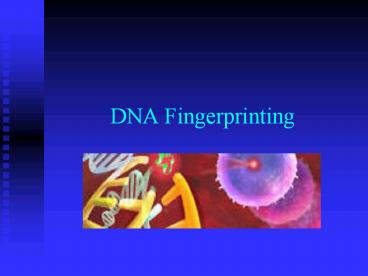DNA Fingerprinting - PowerPoint PPT Presentation
1 / 36
Title: DNA Fingerprinting
1
DNA Fingerprinting
2
Sources of Biological Evidence
- Blood
- Semen
- Saliva
- Urine
- Hair
- Teeth
- Bone
- Tissue
3
Characteristics of DNA
- DNA is a polymer with repeating units called
nucleotides. - Each nucleotide has
- sugar molecule
- phosphate group
- nitrogen containing group (base)
4
Structure of DNA
5
(No Transcript)
6
DNA is a double stranded helix
- Two DNA strands come together to form a DNA
molecule.
7
Selective base pairing holds the strands
together
- Adenine (A) only pairs with Thymine (T)
- Cytosine (C) only pairs with Guanine (G)
8
Complementary Base Pairing
- Bases can occur in any sequence on one strand.
Opposite bases will be on the other strand. - A T C C T G G C T T A T C G C
- T A G G A C C G A A T A G C G
9
Where do proteins come from?
- Proteins are made up of units called amino acids
- Order of the amino acids determines the function
and shape of the protein. - Triplet or three bases ? amino acid
- C-G-T Alanine
- C-T-A Aspartate
10
Normal and sickle cell red blood cells.
11
Genetic diseases
- e.g. Sickle cell anemia mutation in hemoglobin.
- Normal sequence C C T G A G G A G
- Sickle cell anemia C C T G T G G A G
- Changes the amino acid from
- glutamine ? valine
12
Human Genome Project
- Cost 450 million (1990-2003)
- Aim determine the order/sequence of bases on DNA
contained in all 23 chromosomes. - Why?
13
DNA is supercoiled!
14
Replication of DNA
15
Replication of DNA
- Parent strand must unwind.
- Nucleotides are assembled to make new daughter
strand. - Process continues until entire parent strand is
copied. - End up with two exact copies.
16
DNA in the Cell
17
Polymerase Chain Reaction
- DNA (e.g. crime scene, victim, suspect)
- DNA polymerase
- nucleotides (A, T, C, G)
- primers
- Place in Thermal Cycler
- ? multiple, exact copy of original DNA
18
PCR Copies DNA Exponentially through Multiple
Thermal Cycles
In 32 cycles at 100 efficiency, 1.07 billion
copies of targeted DNA region are created
19
Polymerase Chain Reaction (PCR).
20
Restriction enzymes
- Restriction enzymes cut DNA at specific
sequences. - e.g. Eco R1, Hind III, Pst I etc.
- EcoRI
SmaI - sticky ends
blunt ends
21
Recombinant DNA Technology
Plasmid vehicle used to transfer the new DNA
into any cell.
22
DNA Typing
- Not all of DNA sequences code for the production
of proteins - Tandem repeats can distinguish individuals.
23
(No Transcript)
24
(No Transcript)
25
HLA DQ alpha system (DQA 1)
- First commercial and validated PCR-based genetic
marker system. - DNA typing of hair, saliva, semen stains etc.
26
(No Transcript)
27
PCR produces multiple identical copies.
28
How does PCR work?
- Consider, -G-C-T- T-C-C-A-G-
- -C-G-A-A-G-G-T-C-
- Identify primer sequences and design primers.
- Add DNA primers nucleotides (G,A,T,C) DNA
polymerase. - Heat DNA (separate the strands)
- Cool DNA (primers anneal and DNA polymerase
assembles new strand) - 1 CYCLE two complete identical copies of DNA
- PCR animation (http//users.ugent.be/avierstr/pri
nciples/pcrani.html)
29
Short Tandem Repeats (STRs)
- locations (loci)on the chromosome that have
sequence elements that repeat themselves within
the DNA molecule. - 3-7 bases in length, repeated many times.
- Every person has 2 STR types for each
element..one inherited from each parent. - Analysis requires STRs must be identified,
number of repeats defined and sequence of bases
flanking the STR
30
STR Analysis and Multiplexing
- 1. Extract STR (eg. THO1,ie. A-A-T-G) from
biological sample. - 2. Amplify by PCR
- 3. Separate on electrophoresis gel
- 4. Examine the distance moved to estimate to
determine the number of STR repeats that exist. - Multiplexing allows simultaneous extraction and
amplification of a number of different STRs
31
Multiplexing PCR
- Over 10 Markers Can Be Copied at Once
- Sensitivities to levels less than 1 ng of DNA
- Ability to Handle Mixtures and Degraded Samples
- Different Fluorescent Dyes Used to Distinguish
STR Alleles with Overlapping Size Ranges
32
Federal DNA Identification Act
- 1994
- Combined DNA Index System (CODIS) facilitate the
exchange of DNA typing data among police agencies
investigating violent crimes and sexual assaults.
33
DNA Index System
- Mandated collection of
- Collection of DNA samples from convicted
offenders - Establishment of DNA databases for law
enforcement.
34
(No Transcript)
35
Mitochondrial DNA.
- Nuclear DNA (both parents) but mitochondrial DNA
(maternal lineage only). - mtDNA is circular
- mtDNA only contains information for 37 genes.
- 2 regions (HV1 and HV2) have greatest number of
variances.
36
Collection and Preservation of Biological
Evidence for DNA Analysis
- Photograph, notes, sketches
- Assume all body fluids are infectious
- Look for blood in less obvious places.
- Packaging!
- Refrigerate and store away from sunlight.
- DNA control samples.































